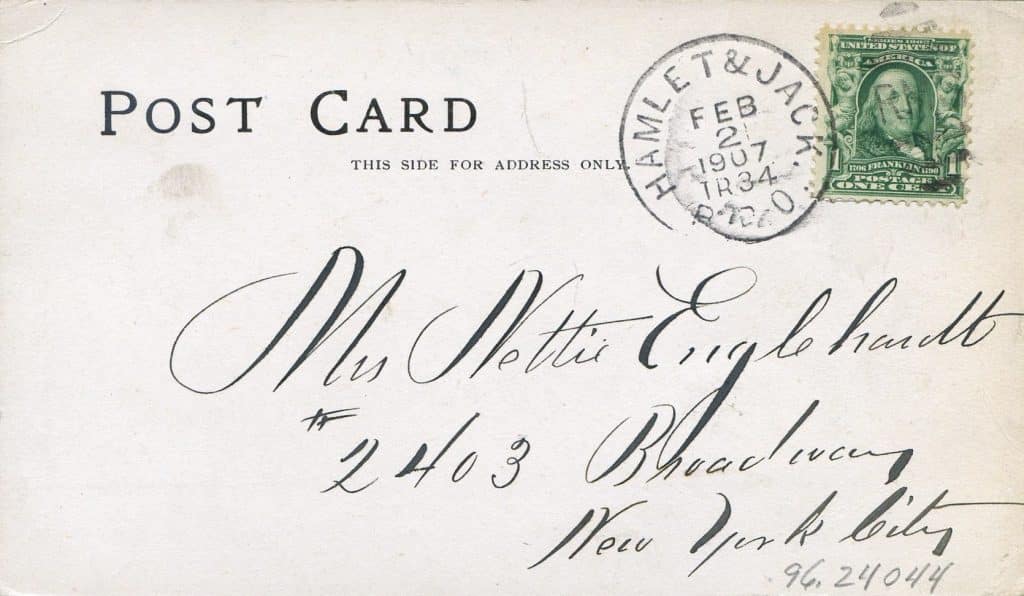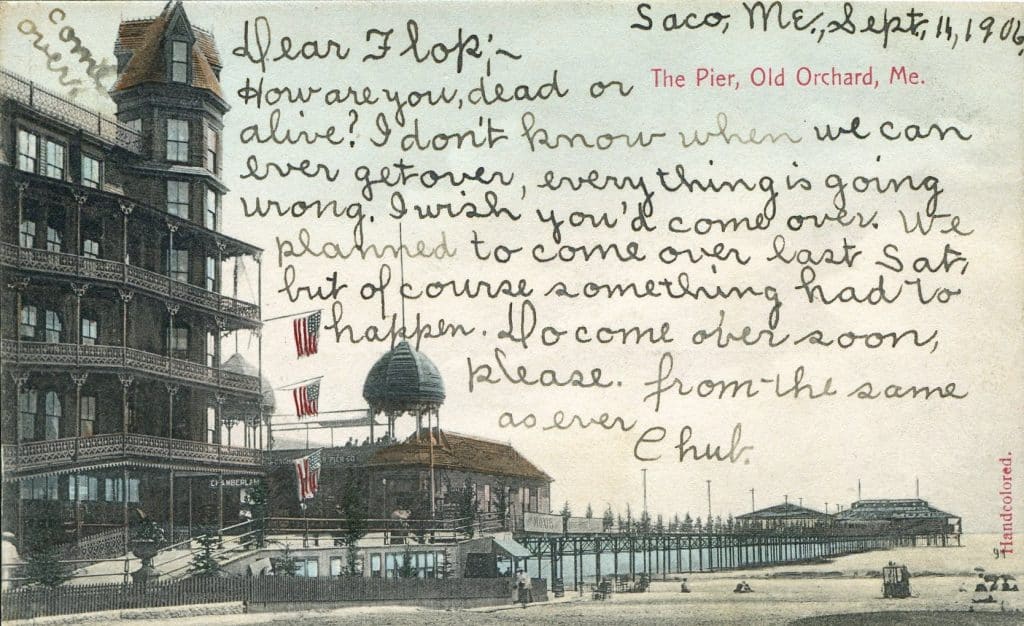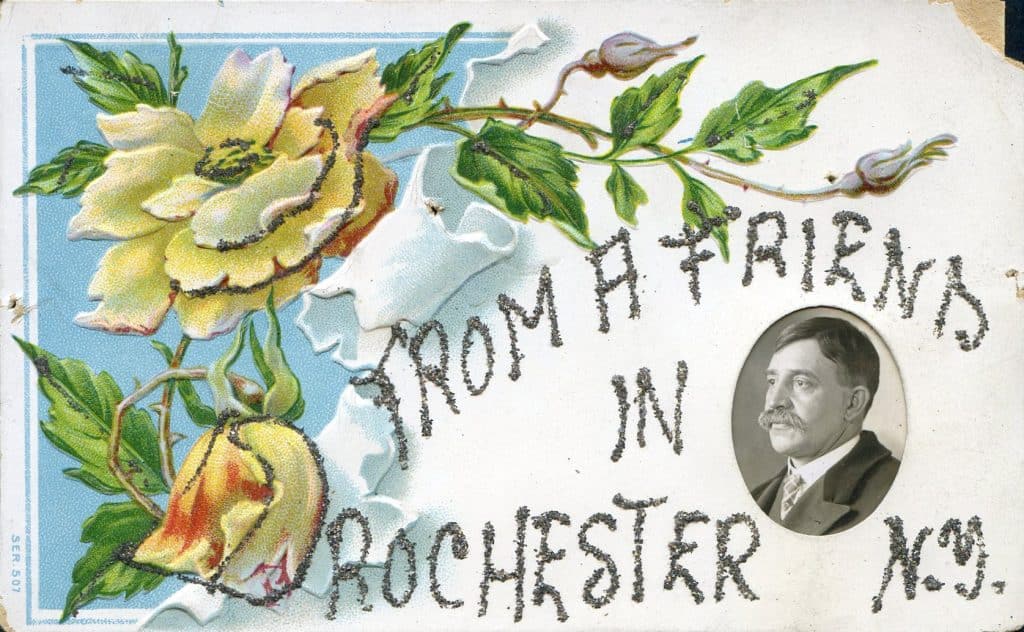Do you remember getting mail? Not email. Not bills. Not letters from credit card companies enthusiastically informing you that you’ve been “pre-approved!” Actual mail—a letter, a note, or a card. You know, when someone wrote you a message, adhered a stamp to it, and placed it in a mailbox, just to let you know they were thinking of you? Chances are you don’t receive this sort of mail nearly as often as you once did, likely due to the influx of digital technology, which facilitates faster, cheaper, and more instantaneous methods of communication.
Rewind nearly a century, long before the invention of computers, cell phones, emails, and text messages. During the early part of the 20th century—from the late 1890s through the late 1920s and even the early 1930s—postcards were a primary form of communication. For just a penny, anyone could send a postcard offering best wishes, documenting travels, or just to say hello.
 Over the past several months, I’ve had the privilege of working with a few (hundred) postcards from our large collection at The Strong. When I first began sorting through the 3”x5” printed cards, most of the examples I cataloged were blank, but I soon encountered postcards with handwritten messages. Instantly, I was intrigued by the lives of the individuals who had both written and received the cards. News from afar, weather reports, travel tales, and humorous anecdotes filled dozens of postcards, many with handwriting so beautiful, it rivaled the artwork on the front.
Over the past several months, I’ve had the privilege of working with a few (hundred) postcards from our large collection at The Strong. When I first began sorting through the 3”x5” printed cards, most of the examples I cataloged were blank, but I soon encountered postcards with handwritten messages. Instantly, I was intrigued by the lives of the individuals who had both written and received the cards. News from afar, weather reports, travel tales, and humorous anecdotes filled dozens of postcards, many with handwriting so beautiful, it rivaled the artwork on the front.
Soon, I discovered entire series of “postals” (as they were often called) written by a single individual and addressed to the same person or family time and again, as the sender traveled from one place to the next. For example, Mr. and Mrs. C. L. Swingley of Riverton Street in Rochester regularly received postcards from their daughter Dana, who traveled around central New York State between 1929 and 1935, writing from places such as Syracuse, Hamilton, and Colgate University where she attended school. Of course, some things don’t change. Often Dana begins by thanking them for a check, then explains that she has been busy with friends; a timeless narrative that echoes the life of a college student. Another couple, Ruth and Amos, documented their 1932 travels around the United States, with multiple postcards sent to a friend in Concord, New Hampshire. A card from the Hotel Mayflower in Jacksonville, Florida, describes one particularly memorable travel experience, in which Ruth wittily writes, “Just came through miles of orange groves and grapefruit. Drank from the fountain of youth, stopped at a crocodile and ostrich farm–saw 6000 crocodiles. Of course I wanted to buy a little one.”
 Some postcards contain less upbeat messages, describing illness or hardship. Oddly enough, my favorite postcard falls into this category, as the sender humorously describes a situation that seems anything but amusing with the following inscription: “Dear Flop, How are you, dead or alive? I don’t know when we can ever get over, everything is going wrong. I wish you’d come over. We planned to come over last Sat., but of course, something had to happen. Do come over soon, please. From, the same as ever, Chub.”
Some postcards contain less upbeat messages, describing illness or hardship. Oddly enough, my favorite postcard falls into this category, as the sender humorously describes a situation that seems anything but amusing with the following inscription: “Dear Flop, How are you, dead or alive? I don’t know when we can ever get over, everything is going wrong. I wish you’d come over. We planned to come over last Sat., but of course, something had to happen. Do come over soon, please. From, the same as ever, Chub.”
After weeks of sorting I now understand the draw of collecting old postcards. The beautiful images, embossed details, handwritten inscriptions, and wonderful names (i.e.: Mr. Monroe Fox, Miss Gazelle Hoffman, or Mr. Otto von Schnieble), combine to create an intensely personal experience. For a moment, we can look into the lives of someone from the past, realizing that although decades have passed, and technology and culture have changed tremendously, people have not. We still travel, we still laugh, and we still endure hardship. We still—possibly more now than ever—have a deep need to communicate regularly and remain connected to those whom we care about most.
 Last summer, a good friend living in Chicago suggested that we start writing letters to one another. With the arrival of his first letter, my mailbox suddenly transformed from an ominous, grey vessel, full of bills and reminders, to a place where I could find entertainment and good news. Receiving a letter improved my whole day. We continued exchanging letters for several months, but eventually became less diligent about writing. Perhaps I’ll revive our pen pal effort by sending a postcard.
Last summer, a good friend living in Chicago suggested that we start writing letters to one another. With the arrival of his first letter, my mailbox suddenly transformed from an ominous, grey vessel, full of bills and reminders, to a place where I could find entertainment and good news. Receiving a letter improved my whole day. We continued exchanging letters for several months, but eventually became less diligent about writing. Perhaps I’ll revive our pen pal effort by sending a postcard.



